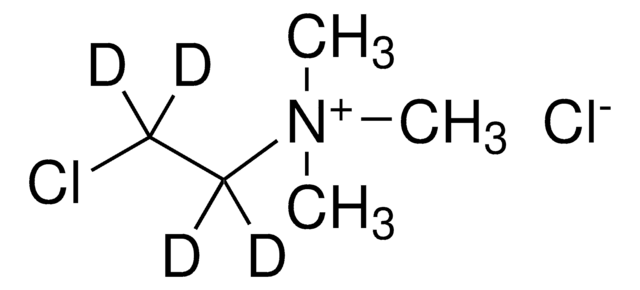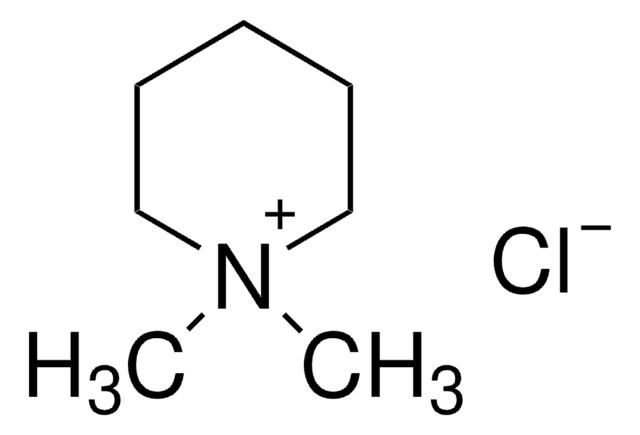93757
Chlorocholine chloride
certified reference material, TraceCERT®, Manufactured by: Sigma-Aldrich Production GmbH, Switzerland
Sinónimos:
Chlorocholine chloride, (2-Chloroethyl)trimethylammonium chloride, Chlormequat chloride, Choline dichloride
About This Item
Productos recomendados
grado
certified reference material
TraceCERT®
Nivel de calidad
Línea del producto
TraceCERT®
caducidad
limited shelf life, expiry date on the label
fabricante / nombre comercial
Manufactured by: Sigma-Aldrich Production GmbH, Switzerland
cadena SMILES
[Cl-].C[N+](C)(C)CCCl
InChI
1S/C5H13ClN.ClH/c1-7(2,3)5-4-6;/h4-5H2,1-3H3;1H/q+1;/p-1
Clave InChI
UHZZMRAGKVHANO-UHFFFAOYSA-M
¿Está buscando productos similares? Visita Guía de comparación de productos
Categorías relacionadas
Descripción general
Certified content by quantitative NMR incl. uncertainty and expiry date are given on the certificate.
Download your certificate at: http://www.sigma-aldrich.com
Chlormequat chloride, also known as chlorocholine chloride (CCC) is the most widely used plant growth regulator that inhibits the biosynthesis of gibberellins. CCC is applied in agriculture and horticulture to promote sturdier growth by reducing the height of grain crops and increasing the diameter of the stems without causing a loss of plant productivity.
Chlormequat chloride has to be monitored in the Multiannual Control Programme for Pesticides Residues (MACP), run within the EU and EFTA in/on products of plant origin.
The European Communities (EC) have established maximum residue limits (MRLs) for CCC at 2 mg/kg for wheat, barley, and rye, 5 mg/kg for oat, and 0.05 mg/kg for other cereals. The agreed values of CCC as reported by EFSA are 0.04 mg/kg bw/day for the Acceptable Daily Intake (ADI), 0.04 mg/kg bw/day for the Acceptable Operator Exposure Level (AOEL), and 0.09 mg/kg bw/day for the Acute Reference Dose (ARfD).
According to Regulation (EU) No 540/2011, chlormequat is deemed to have been approved under Regulation (EC) No 1107/2009. This approval is restricted to its use as only a plant growth regulator.
Aplicación
- Investigate the effect of drought on plant growth, essential oil concentration, oil biosynthesis, and peroxidase activity in the leaves of C. martinii and C. winterianus
- Study the effect of ethrel, chlormequat chloride, and paclobutrazol on growth and pyrethrins levels in Chrysanthemum cinerariaefolium Vis.
- Study the effect of chlormequat chloride (CCC) application at the bolting stage on the flowering, seed yield, and seed quality of lettuce plants previously treated with water or gibberellic acid (GA3)
- Investigate the effects of nitrogen rate, seed rate, and chlormequat chloride on the grain quality of oats (Avena sativa)
Productos recomendados
Información legal
¿No encuentra el producto adecuado?
Pruebe nuestro Herramienta de selección de productos.
Palabra de señalización
Danger
Frases de peligro
Consejos de prudencia
Clasificaciones de peligro
Acute Tox. 3 Dermal - Acute Tox. 4 Oral
Código de clase de almacenamiento
6.1C - Combustible acute toxic Cat.3 / toxic compounds or compounds which causing chronic effects
Clase de riesgo para el agua (WGK)
WGK 2
Punto de inflamabilidad (°F)
Not applicable
Punto de inflamabilidad (°C)
Not applicable
Elija entre una de las versiones más recientes:
Certificados de análisis (COA)
¿No ve la versión correcta?
Si necesita una versión concreta, puede buscar un certificado específico por el número de lote.
¿Ya tiene este producto?
Encuentre la documentación para los productos que ha comprado recientemente en la Biblioteca de documentos.
Nuestro equipo de científicos tiene experiencia en todas las áreas de investigación: Ciencias de la vida, Ciencia de los materiales, Síntesis química, Cromatografía, Analítica y muchas otras.
Póngase en contacto con el Servicio técnico






